Kinematics and Timing Constraints in a Transpressive Tectonic Regime: The Example of the Posada-Asinara Shear Zone (NE Sardinia, Italy)
Abstract
1. Introduction
2. Geological Setting
3. Field Data, Deformation History and Mesoscale Observations
4. Microstructures
5. Vorticity and Finite Strain of the PASZ
5.1. Methodology
5.2. Vorticity and Finite Strain Results and Implications
6. U–(Th)–Pb Monazite Geochronology
6.1. Methods and Analytical Techniques
6.2. Monazite Mineral Chemistry, Zoning and Isotopic Results
7. Discussion
7.1. Geometry and Strain Partitioning of the PASZ
7.2. Kinematics of the PASZ
7.3. Monazite Chemistry and Dating: Timing of Deformation in the PASZ
7.4. PASZ in the Framework of Late Variscan Shearing
8. Conclusions
- New meso- and microstructural data, combined with the kinematics of the flow and finite strain analysis, point to an increase of the simple shear component approaching the high-strain sector of the PASZ. The principal structures of the D2 phase are controlled by a deformation in which the strain is partitioned into folds and shear zone domains.
- The transpressive activity and non-coaxial flow, coupled with an oblate finite strain ellipsoid and a variable convergence angle, suggests that the PASZ evolved from a type B (pure shear-dominated transpression) to a type C (simple shear-dominated transpression) shear zone models (Fossen and Tikoff, 1998 [79]).
- Texturally-controlled U–(Th)–Pb geochronology on monazite reveals that the onset and the progressive evolution of the PASZ lasted from ~325 up to ~300 Ma, in a time span of ~25 Ma, and culminated with copious granitoid magmatism at ~300 Ma. The PASZ evolved from the amphibolite-facies condition down to the greenschist-facies condition. The collisional stage, and prograde metamorphism, before the transpressive deformation, occurred at ~330 Ma.
9. Computer Code and Software
Supplementary Materials
Author Contributions
Funding
Acknowledgments
Conflicts of Interest
References
- Ramsay, J.G.; Graham, R.H. Strain variation in shear belts. Can. J. Earth Sci. 1970, 7, 786–813. [Google Scholar] [CrossRef]
- Ramsay, J.G. Shear zone geometry: A review. J. Struct. Geol. 1980, 2, 83–99. [Google Scholar] [CrossRef]
- Passchier, C.W.; Ten Brink, C.E.; Bons, P.D.; Sokoutis, D. δ objects as a gauge for stress sensitivity of strain rate in mylonites. Earth Planet. Sci. Lett. 1993, 120, 239–245. [Google Scholar] [CrossRef]
- Fossen, H.; Cavalcante, G.C.G. Shear zones—A review. Earth Sci. Rev. 2017. [Google Scholar] [CrossRef]
- Goscombe, B.D.; Hand, M.; Gray, D.; Mawby, J. The metamorphic architecture of a transpressional orogen: The Kaoko belt, Namibia. J. Petrol. 2003, 44, 679–711. [Google Scholar] [CrossRef]
- Goscombe, B.D.; Gray, D.; Armstrong, R.; Foster, D.A.; Vogl, J. Event geochronology of the pan-African Kaoko belt, Namibia. Precambrian Res. 2005, 140, 103.e1–103.e41. [Google Scholar] [CrossRef]
- Law, R.D.; Searle, M.P.; Simpson, R.L. Strain, deformation temperatures and vorticity of flow at the top of the Greater Himalayan Slab, Everest Massif, Tibet. J. Geol. Soc. 2004, 161, 305–320. [Google Scholar] [CrossRef]
- Iacopini, D.; Carosi, R.; Montomoli, C.; Passchier, C.W. Strain analysis and vorticity of flow in the northern sardinian variscan belt: Recognition of a partitioned oblique deformation event. Tectonophysics 2008, 446, 77–96. [Google Scholar] [CrossRef]
- Carosi, R.; Montomoli, C.; Tiepolo, M.; Frassi, C. Geochronological constraints on post-collisional shear zones in the Variscides of Sardinia (Italy). Terra Nov. 2012, 24, 42–51. [Google Scholar] [CrossRef]
- Carosi, R.; Lombardo, B.; Molli, G.; Musumeci, G.; Pertusati, P.C. The South Tibetan detachment system in the Rongbuk valley, Everest region. Deformation features and geological implications. J. Asian Earth Sci. 1998, 16, 299–311. [Google Scholar] [CrossRef]
- Carosi, R.; Montomoli, C.; Rubatto, D.; Visonà, D. Normal-sense shear zones in the core of the Higher Himalayan crystallines (Bhutan Himalayas): Evidence for extrusion? Geol. Soc. Spec. Publ. 2006, 268, 425–444. [Google Scholar] [CrossRef]
- Passchier, C.W. Stable positions of rigid objects in non-coaxial flow—A study in vorticity analysis. J. Struct. Geol. 1987, 9, 679–690. [Google Scholar] [CrossRef]
- Passchier, C.W. Geometric constraints on the development of shear bands in rocks. Neth. J. Geosci. 1991, 70, 203–211. [Google Scholar]
- Iacopini, D.; Carosi, R.; Xypolias, P. Implications of complex eigenvalues in homogeneous flow: A three-dimensional kinematic analysis. J. Struct. Geol. 2010, 32, 93–106. [Google Scholar] [CrossRef]
- Iacopini, D.; Frassi, C.; Carosi, R.; Montomoli, C. Biases in the three-dimensional vorticity analysis using porphyroclast system: Limits and application to natural examples. Geol. Soc. Spec. Publ. 2011, 360, 301–318. [Google Scholar] [CrossRef]
- Grasemann, B.; Fritz, H.; Vannay, J.C. Quantitative kinematic flow analysis from the Main Central Thrust Zone (Nw-Himalaya, India): Implications for a decelerating strain path and the extrusion of orogenic wedges. J. Struct. Geol. 1999, 21, 837–853. [Google Scholar] [CrossRef]
- Carosi, R.; Palmeri, R. Orogen-parallel tectonic transport in the variscan belt of northeastern Sardinia (Italy): Implications for the exhumation of medium-pressure metamorphic rocks. Geol. Mag. 2002, 139, 497–511. [Google Scholar] [CrossRef]
- Simonetti, M.; Carosi, R.; Montomoli, C.; Langone, A.; D’addario, E.; Mammoliti, E. Kinematic and geochronological constraints on shear deformation in the Ferriere-Mollières shear zone (Argentera-Mercantour Massif, Western Alps): Implications for the evolution of the Southern European Variscan Belt. Int. J. Earth Sci. 2018, 107, 2163–2189. [Google Scholar] [CrossRef]
- Xypolias, P. Vorticity analysis in shear zones: A review of methods and applications. J. Struct. Geol. 2010, 32, 2072–2092. [Google Scholar] [CrossRef]
- Lin, S.; Jiang, D.; Williams, P.F. Discussion on transpression and transtension zones. J. Geol. Soc. 1999, 156, 1045–1048. [Google Scholar]
- Hunter, J.R.; Weinberg, R.F.; Wilson, C.J.L.; Luzin, V.; Misra, S. Quartz deformation across interlayered monomineralic and polymineralic rocks: A comparative analysis. J. Struct. Geol. 2019, 119, 118–134. [Google Scholar] [CrossRef]
- Kurz, G.A.; Northrup, C.J. Structural analysis of mylonitic fault rocks in the Cougar Creek Complex, Oregon-Idaho using the porphyroclast hyperbolic distribution method, and potential use of sc’-type extensional shear bands as quantitative vorticity indicators. J. Struct. Geol. 2008, 30, 1005–1012. [Google Scholar] [CrossRef]
- Carosi, R.; Frassi, C.; Montomoli, C. Deformation during exhumation of medium- and high-grade metamorphic rocks in the Variscan chain in northern Sardinia (Italy). Geol. J. 2009, 44, 280–305. [Google Scholar] [CrossRef]
- Festa, V. The amount of pure shear and thinning in the Hercynian continental lower crust exposed in the Serre Massif (Calabria, southern Italy): An application of the vorticity analysis to quartz c-axis fabrics. Ital. J. Geosci. 2014, 133, 214–222. [Google Scholar] [CrossRef]
- Montomoli, C.; Iaccarino, S.; Carosi, R.; Langone, A.; Visonà, D. Tectonometamorphic discontinuities within the Greater Himalayan Sequence in Western Nepal (Central Himalaya): Insights on the exhumation of crystalline rocks. Tectonophysics 2013, 608, 1349–1370. [Google Scholar] [CrossRef]
- Fazio, E.; Punturo, R.; Cirrincione, R.; Kern, H.; Pezzino, A.; Wenk, H.R.; Goswami, S.; Mamtani, M.A. Quartz preferred orientation in naturally deformed mylonitic rocks (Montalto shear zone-Italy): A comparison of results by different techniques, their advantages and limitations. Int. J. Earth Sci. 2017, 106, 2259–2278. [Google Scholar] [CrossRef]
- Carosi, R.; Oggiano, G. Transpressional deformation in northwestern Sardinia (Italy): Insights on the tectonic evolution of the Variscan belt. C. R. Geosci. 2002, 334, 287–294. [Google Scholar] [CrossRef]
- Di Vincenzo, G.; Carosi, R.; Palmeri, R. The relationship between tectono-metamorphic evolution and argon isotope records in white mica: Constraints from in situ 40Ar-39Ar laser analysis of the Variscan basement of Sardinia. J. Petrol. 2004, 45, 1013–1043. [Google Scholar] [CrossRef]
- Carosi, R.; Frassi, C.; Iacopini, D.; Montomoli, C. Post-collisional transpressive tectonic in northern Sardinia (Italy). J. Virtual Explor. 2005, 19, 1441–8142. [Google Scholar] [CrossRef]
- Matte, P. Tectonics and plate tectonics model for the Variscan belt of Europe. Tectonophysics 1986, 126, 329–374. [Google Scholar] [CrossRef]
- Franke, W. Tectonostratigraphic units in the Variscan belt of central Europe. Geol. Soc. Am. 1989, 30, 67–90. [Google Scholar]
- Dias, R.; Ribeiro, A. The Ibero-Armorican Arc. A collision effect against an irregular continent? Tectonophysics 1995, 246, 113–128. [Google Scholar] [CrossRef]
- Fernández-Lozano, J.; Pastor-Galán, D.; Gutiérrez-Alonso, G.; Franco, P. New kinematic constraints on the Cantabrian orocline: A paleomagnetic study from the Peñalba and Truchas synclines, NW Spain. Tectonophysics 2016, 681, 195–208. [Google Scholar] [CrossRef]
- Matte, P. The Variscan collage and orogeny (480–290 ma) and the tectonic definition of the Armorica microplate: A review. Terra Nov. 2001, 13, 117–121. [Google Scholar] [CrossRef]
- Corsini, M.; Rolland, Y. Late evolution of the southern European Variscan Belt: Exhumation of the lower crust in a context of oblique convergence. C. R. Geosci. 2009, 341, 214–223. [Google Scholar] [CrossRef]
- Carmignani, L.; Carosi, R.; Di Pisa, A.; Gattiglio, M.; Musumeci, G.; Oggiano, G.; Pertusati, P.C. The Hercynian Chain in Sardinia (Italy). Geodin. Acta 1994, 7, 31–47. [Google Scholar] [CrossRef]
- Montomoli, C. Zone di taglio fragili-duttili nel basamento varisico metamorfico di basso grado della Nurra meridionale (Sardegna nord-occidentale). Atti della Soc. Toscana di Sci. Nat. Mem Ser. A 2003, 108, 23–29. [Google Scholar]
- Montomoli, C.; Iaccarino, S.; Simonetti, M.; Lezzerini, M.; Carosi, R. Structural setting, kinematics and metamorphism in a km-scale shear zone in the inner nappes of Sardinia (Italy). Ital. J. Geosci. 2018, 137, 294–310. [Google Scholar] [CrossRef]
- Franceschelli, M.; Memmi, I.; Ricci, C.A. Ca distribution between garnet and plagioclase in pelitic and psammitic schists from the metamorphic basement of north eastern Sardinia. Contrib. Miner. Petr. 1982, 80, 285–295. [Google Scholar] [CrossRef]
- Carmignani, L.; Oggiano, G.; Barca, S.; Cont, I.P.; Salvadori, I.; Eltrudis, A.; Funedda, A.; Pasci, S. Geologia della Sardegna; Note Illustrative della Carta Geologica della Sardegna in scala 1:200.000. Mem. Descr. Carta Geol. d’Italiana 2001, 60, 283. [Google Scholar]
- Musumeci, G. Displacement calculation in a ductile shear zone: Monte Grighini shear zone (Central-Western Sardinia). Bull. Soc. Geol. Italiana 1991, 110, 771–777. [Google Scholar]
- Ferrara, G.; Ricci, C.A.; Rita, F. Isotopic ages and tectonometamorphic history of the metamorphic basement of north-eastern Sardinia. Contrib. Miner. Petr. 1978, 68, 99–106. [Google Scholar] [CrossRef]
- Helbing, H.; Tiepolo, M. Age determination of Ordovician magmatism in Ne Sardinia and its bearing on Variscan basement evolution. J. Geol. Soc. 2005, 162, 689–700. [Google Scholar] [CrossRef]
- Massonne, H.J.; Cruciani, G.; Franceschelli, M. Geothermobarometry on anatectic melts- a high-pressure Variscan migmatite from NE Sardinia. Int. Geol. Rev. 2013, 55, 1490–1505. [Google Scholar] [CrossRef]
- Franceschelli, M.; Carcangiu, G.; Caredda, A.M.; Cruciani, G.; Memmi, I.; Zucca, M. Transformation of cumulate mafic rocks to granulite and re-equilibration in amphibolite and greenschist facies in NE Sardinia, Italy. Lithos 2007, 63, 1–18. [Google Scholar] [CrossRef]
- Ghezzo, C.; Memmi, I.; Ricci, C.A. Un evento granulitico nella Sardegna nord-orientale. Mem. della Soc. Geol. Italiana 1979, 20, 23–38. [Google Scholar]
- Elter, F.M.; Musumeci, G.; Pertusati, P.C. Late Hercynian shear zones in Sardinia. Tectonophysics 1990, 176, 387–404. [Google Scholar] [CrossRef]
- Barca, S.; Corradini, C.; Ferretti, A.; Olivieri, R.; Serpagli, E. Conodont biostratigraphy of the “Ockerkalk” (Silurian) from southeastern Sardinia. Riv. Ital. Paleontol. Sardinia 1995, 100, 459–476. [Google Scholar]
- Cruciani, G.; Franceschelli, M.; Massonne, H.-J.; Carosi, R.; Montomoli, C. Pressure–temperature and deformational evolution of high-pressure metapelites from Variscan Ne Sardinia, Italy. Lithos 2013, 175–176, 272–284. [Google Scholar] [CrossRef]
- Ricci, C.A.; Carosi, R.; Di Vincenzo, G.; Franceschelli, M.; Palmeri, R. Unravelling the tectono-metamorphic evolution of medium-pressure rocks from collision to exhumation of the Variscan basement of NE Sardinia: A review. Period Miner. 2004, 73, 73–83. [Google Scholar]
- Franceschelli, M.; Memmi, I.; Pannuti, F.; Ricci, C.A. Diachronous metamorphic equilibria in the Hercynian basement of northern Sardinia, Italy. Geol. Soc. Spec. Publ. 1989, 43, 371–375. [Google Scholar] [CrossRef]
- Ricci, C.A. From crustal thickening to exhumation: Petrological, structural and geochronological records. IGCP 1992, 276, 187–197. [Google Scholar]
- England, P.C.; Thompson, A.B. Pressure–temperature–time paths of regional metamorphism. I. Heat transfer during the evolution of regions of thickened continental crust. J. Petrol. 1984, 25, 894–928. [Google Scholar] [CrossRef]
- Del Moro, A.; Di Pisa, A.; Oggiano, G.; Villa, I.M. Isotopic ages of two contrasting tectonomorphic episodes in the Variscan Chain in N Sardinia. In Geologia Del Basamento Italiano; Lazzarotto, A., Morten, L., Ricci, C.A., Sassi, F.P., Vai, G.B., Eds.; A congress dedicated to Tommaso Cocozza, Dipartimento di Scienze della Terra & Centro Offset: Siena, Italy, 1991; pp. 33–35. [Google Scholar]
- Frassi, C.; Carosi, R.; Montomoli, C.; Law, R.D. Kinematics and vorticity of flow associated with post-collisional oblique transpression in the Variscan Axial Zone of northern Sardinia (Italy). J. Struct. Geol. 2009, 31, 1458–1471. [Google Scholar] [CrossRef]
- Graziani, R.; Montomoli, C.; Iaccarino, S.; Menegon, L.; Nania, L.; Carosi, R. Structural setting of a transpressive shear zone: Insights from geological mapping, quartz petrofabric and kinematic vorticity analysis in NE Sardinia (Italy). Geol. Mag. 2020, 1–19. [Google Scholar] [CrossRef]
- Del Moro, A.; Di Simplicio, P.; Ghezzo, C.; Guasparri, G.; Rita, F.; Sabatini, G. Radiometric data and intrusive sequence in the Sardinian batholith. Neues Jahrb. für Mineral. Abh. 1975, 126, 28–44. [Google Scholar]
- Elter, F.M.; Franceschelli, M.; Ghezzo, C.; Memmi, I.; Ricci, C.A. The Geology of Northern Sardinia. In Guide-Book to the Excursion on the Paleozoic Basement of Sardinia; IGCP no. 5, Newsletter, Special Issue; Carmignani, L., Cocozza, T., Ghezzo, C., Pertusati, P.C., Ricci, C.A., Eds.; Tipogragia Pacini: Pisa, Italy, 1986; pp. 87–102. [Google Scholar]
- Ramsay, J.G. Folding and Fracturing of Rocks; Mcgraw-Hill: New York, NY, USA, 1967; pp. 1–568. [Google Scholar]
- Hudleston, P. Fold morphology and some geometrical implications of theories of fold development. Tectonophysics 1973, 16, 1–46. [Google Scholar] [CrossRef]
- Piazolo, S.; Passchier, C.W. Control on lineation development in low to medium grade shear zones: A study from the Cap de Creus Penisula, Ne Spain. J. Struct. Geol. 2002, 24, 25–44. [Google Scholar] [CrossRef]
- Whitney, D.; Evans, B. Abbreviations for names of rock-forming minerals. Am. Min. 2010, 95, 185–187. [Google Scholar] [CrossRef]
- Stipp, M.; Stünitz, H.; Heilbron, M.; Schmid, D.W. The eastern tonale fault zone: A natural laboratory for crystal plastic deformation of quartz over a temperature range from 250 to 700 °C. J. Struct. Geol. 2002, 24, 1861–1884. [Google Scholar] [CrossRef]
- Passchier, C.W.; Trouw, R.A.J. Microtectonics, 2nd ed.; Springer: Berlin/Heidelberg, Germany, 2005; pp. 1–366. [Google Scholar] [CrossRef]
- White, S.H. The role of dislocation process during tectonic deformation with special reference to quartz. In The Physics and Chemistry of Mineral and Rocks; Strens, R.G.J., Ed.; John Wiley & Sons: London, UK, 1976; pp. 75–91. [Google Scholar]
- Wallis, S.R.; Platt, J.P.; Knott, S.D. Recognition of synconvergence extension in accretionary wedges with examples from the Caiabrian Arc and the Eastern Alps. Am. J. Sci. 1993, 293, 463–495. [Google Scholar] [CrossRef]
- Bobyarchick, A.R. The eigenvalues of steady flow in Mohr space. Tectonophysics 1986, 122, 35–51. [Google Scholar] [CrossRef]
- Passchier, C.W. Analysis of deformation paths in shear zones. Geol. Rundsh. 1988, 77, 309–318. [Google Scholar] [CrossRef]
- Platt, J.P.; Vissers, R.L.M. Extensional structures in anisotropic rocks. J. Struct. Geol. 1980, 2, 397–410. [Google Scholar] [CrossRef]
- Simpson, C.; De Paor, D.G. Strain and kinematic analysis in general shear zones. J. Struct. Geol. 1993, 15, 1–20. [Google Scholar] [CrossRef]
- Jeffery, G.B. The motion of ellipsoidal particles immersed in a viscous fluid. Proc. R. Soc. A-Math. Phys. 1922, 102, 161–179. [Google Scholar] [CrossRef]
- Mulchrone, K. An analytical solution in 2D for the motion of rigid elliptical particles with a slipping interface under a general deformation. J. Struct. Geol. 2007, 29, 950–960. [Google Scholar] [CrossRef]
- Mulchrone, K. Shape fabrics in populations of rigid object in 2D: Estimating finite strain and vorticity. J. Struct. Geol. 2007, 29, 1558–1570. [Google Scholar] [CrossRef]
- Vollmer, F.W. Ellipsefit 3 User Manual; 2015; p. 72. Available online: https://www.frederickvollmer.com/ellipsefit/ (accessed on 10 July 2020).
- Fossen, H.; Tikoff, B. The deformation matrix for simultaneous simple shearing, pure shearing and volume change, and its application to transpression-transtension tectonics. J. Struct. Geol. 1993, 15, 413–422. [Google Scholar] [CrossRef]
- Fossen, H.; Tikoff, B.; Teyssier, C. Strain modeling of transpressional and transtensional deformation. Norsk Geologisk Tidsskrift 1994, 74, 134–145. [Google Scholar]
- Fry, N. Random point distribution and strain measurement in rocks. Tectonophysics 1979, 60, 89–105. [Google Scholar] [CrossRef]
- Ramsay, J.G.; Huber, M.I. The Techniques of Modern Structural Geology. Volume 1: Strain Analysis; Academic Press: London, UK, 1983; p. 307. [Google Scholar] [CrossRef]
- Fossen, H.; Tikoff, B. Extended models of transpression and transtension, and applications to tectonic settings. Geol. Soc. Spec. Publ. 1998, 135, 15–33. [Google Scholar] [CrossRef]
- Law, R.D. Moine Thrust zone mylonites at the Stack of Glencoul: II—Results of vorticity analyses and their tectonic significance. Geol. Soc. Spec. Publ. 2010, 335, 579–602. [Google Scholar] [CrossRef]
- Fossen, H. Structural Geology; Cambridge University Press: Cambridge, UK, 2010; p. 463. [Google Scholar]
- Vannay, J.C.; Grasemann, B. Himalayan inverted metamorphism and syn-convergence extension as a consequence of a general shear extrusion. Geol. Mag. 2001, 138, 253–276. [Google Scholar] [CrossRef]
- Thigpen, J.R.; Law, R.D.; Lloyd, G.E.; Brown, S.J.; Cook, B. Deformation temperatures, vorticity of flow and strain symmetry in the Loch Eriboll mylonites, NW Scotland: Implications for kinematic and structural evolution of the northernmost Moine thrust zone. Geol. Soc. Spec. Publ. 2010, 335, 623–662. [Google Scholar] [CrossRef]
- Bosse, V.; Villa, I. Petrochronology, hygrochronology of tectono-metamorphic events. Gondwana Res. 2019, 71, 76–90. [Google Scholar] [CrossRef]
- Williams, M.L.; Jercinovic, M.J.; Hetherington, C.J. Microprobe monazite geochronology: Understanding geologic processes by integrating composition and chronology. Annu. Rev. Earth Planet. Sci. 2007, 35, 137–175. [Google Scholar] [CrossRef]
- Tiepolo, M. In situ Pb geochronology of zircon with laser ablation-inductively coupled plasma-sector field mass spectrometry. Chem. Geol. 2003, 199, 159–177. [Google Scholar] [CrossRef]
- Paquette, J.L.; Tiepolo, M. High resolution (5 µm) U–Th–Pb isotope dating of monazite with excimer laser ablation (ELA)-ICPMS. Chem. Geol. 2007, 240, 222–237. [Google Scholar] [CrossRef]
- Seydoux-Guillaume, A.M.; Paquette, J.L.; Wiedenbeck, M.; Montel, J.M.; Heinrich, W. Experimental resetting of the U-Th-Pb systems in monazite. Chem. Geol. 2002, 191, 165–181. [Google Scholar] [CrossRef]
- Seydoux-Guillaume, A.M.; Wirth, R.; Nasdala, L.; Gottschalk, M.; Montel, J.M.; Heinrich, W. An XRD, TEM and Raman study of experimentally annealed natural monazite. Phys. Chem. Miner. 2002, 29, 240–253. [Google Scholar] [CrossRef]
- Ludwig, K.R. Isoplot/Ex Version 3.00: A Geochronological Toolkit for Microsoft Excel; Berkeley Geochronology Center: Berkeley, CA, USA, 2003. [Google Scholar]
- Vermeesch, P. IsoplotR: A free and open toolbox for geochronology. Geosci. Front. 2018, 9, 1479–1493. [Google Scholar] [CrossRef]
- Carosi, R.; Di Pisa, A.; Iacopini, D.; Montomoli, C.; Oggiano, G. The structural evolution of the Asinara Island (NW Sardinia, Italy). Geodin. Acta 2004, 17, 309–329. [Google Scholar] [CrossRef]
- Giacomini, F.; Bomparola, R.M.; Ghezzo, C. Petrology and geochronology of metabasites with eclogite facies relics from NE Sardinia: Constraints for the Palaeozoic evolution of Southern Europe. Lithos 2005, 82, 221–248. [Google Scholar] [CrossRef]
- Jones, R.R.; Tanner, P.W. Strain partitioning in transpression zones. J. Struct. Geol. 1995, 17, 793–802. [Google Scholar] [CrossRef]
- Pyle, J.M.; Spear, F.S. Yttrium zoning in garnet: Coupling of major and accessory phases during metamorphic reactions. Geol. Mat. Res. 1999, 1, 1–49. [Google Scholar]
- Kohn, M.J. Metamorphic chronology comes of age: Past achievements and future prospects. Am. Min. 2016, 101, 25–42. [Google Scholar] [CrossRef]
- Spear, F.S. Monazite–allanite phase relations in metapelites. Chem. Geol. 2010, 279, 55–62. [Google Scholar] [CrossRef]
- Giacomini, F.; Bomparola, R.M.; Ghezzo, C.; Guldbransen, H. The geodynamic evolution of the Southern European Variscides: Constraints from the U/Pb geochronology and geochemistry of the lower Paleozoic magmatic-sedimentary sequences of Sardinia (Italy). Contrib. Miner. Petrol. 2006, 152, 19–42. [Google Scholar] [CrossRef]
- Casini, L.; Cuccuru, S.; Maino, M.; Oggiano, G.; Tiepolo, M. Emplacement of the Arzachena Pluton (Corsica–Sardinia Batholith) and the geodynamics of incoming Pangaea. Tectonophysics 2012, 544–545, 31–49. [Google Scholar] [CrossRef]
- Simonetti, M.; Carosi, R.; Montomoli, C.; Corsini, M.; Petroccia, A.; Cottle, J.M.; Iaccarino, S. Timing and kinematics of the flow in a transpressive dextral shear zone, Maures Massif (Southern France). Int. J. Earth Sci. 2020, 1437–3262. [Google Scholar] [CrossRef]
- Simonetti, M.; Carosi, R.; Montomoli, C.; Cottle, J.M.; Law, R.D. Transpressive deformation in the Southern Europe Variscan Belt: New insights from the Aiguilles Rouges Massif (Western Alps). Tectonics 2020, 39, e2020TC006153. [Google Scholar]
- Giacomini, F.; Dallai, L.; Carminati, E.; Tiepolo, M.; Ghezzo, G. Exhumation of a Variscan orogenic complex: Insights into the composite granulitic–amphibolitic metamorphic basement of South-East Corsica (France). J. Metamorph. Geol. 2008, 26, 403–436. [Google Scholar] [CrossRef]
- Holcombe, R. Straincalculator 3.2.; 2009. Available online: https://www.holcombe.net.au/software/straincalculator.html (accessed on 10 July 2020).
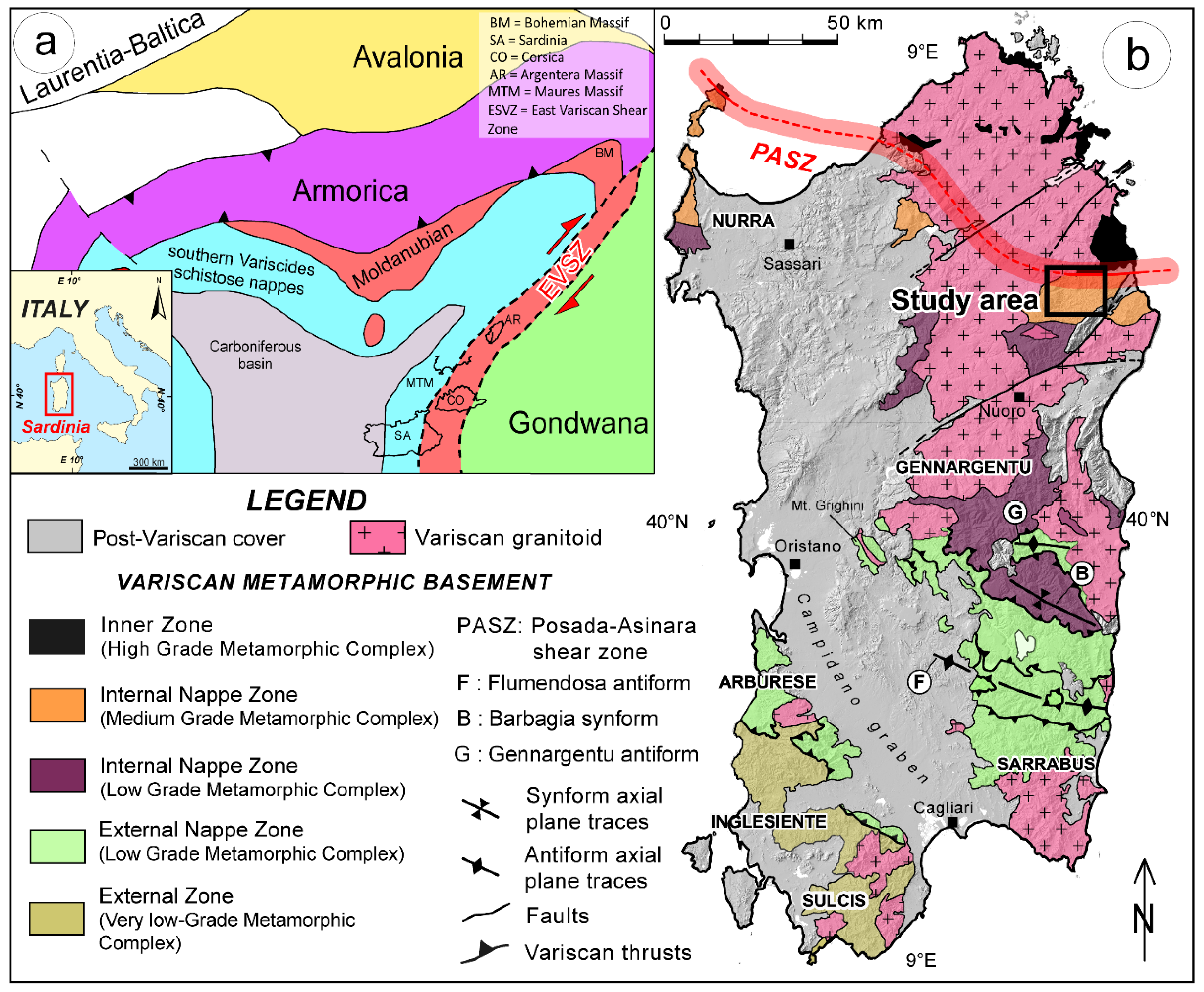
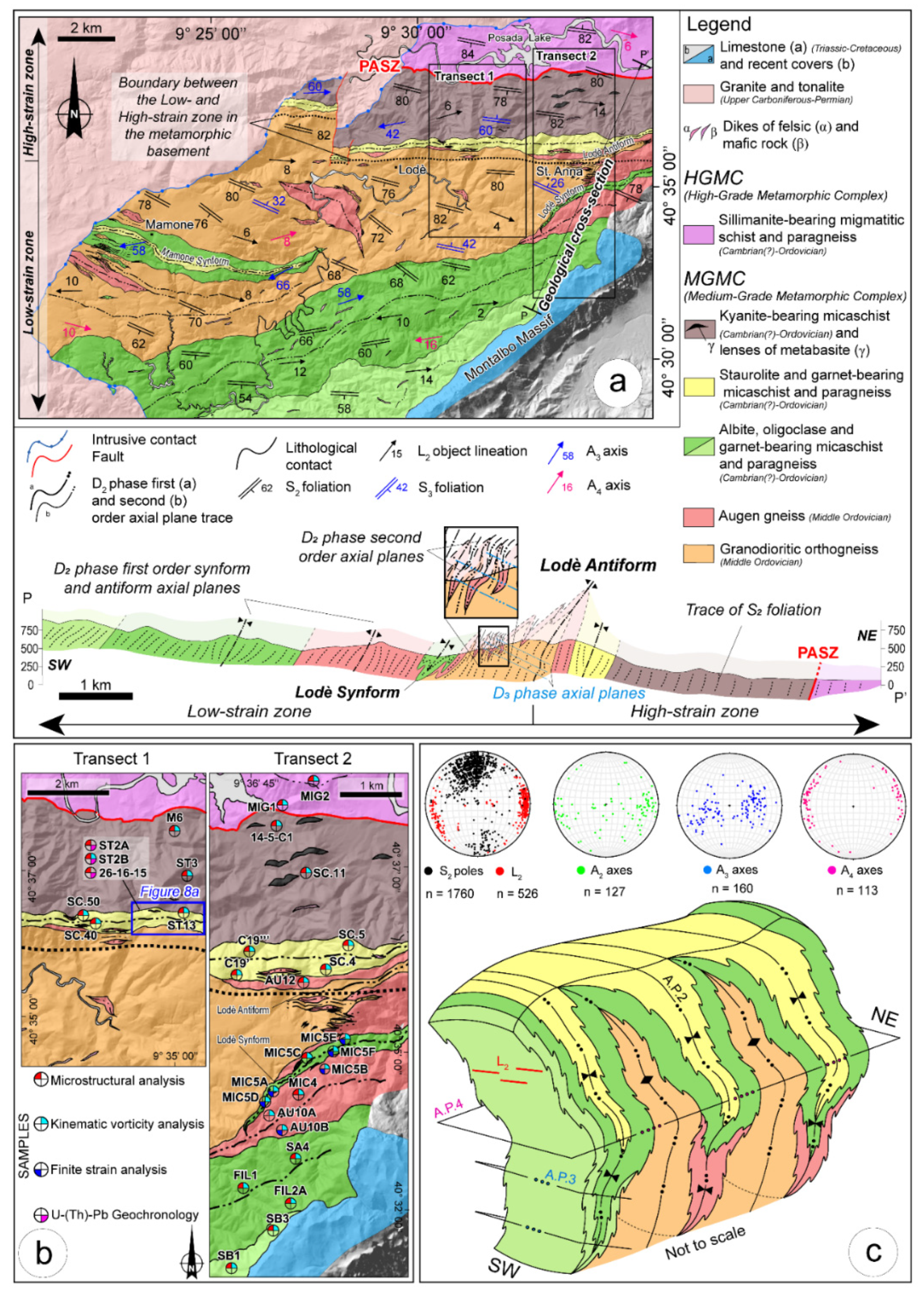

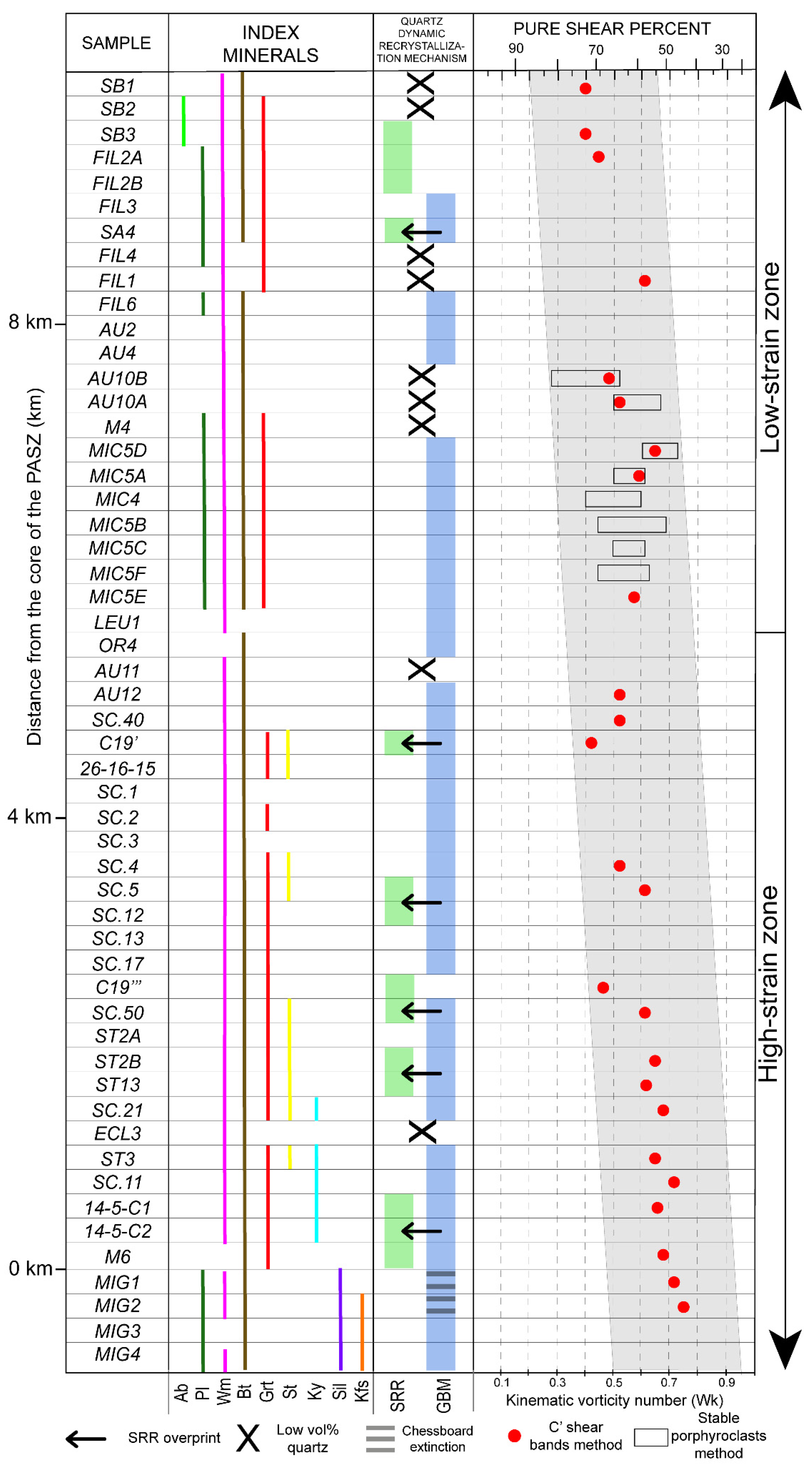
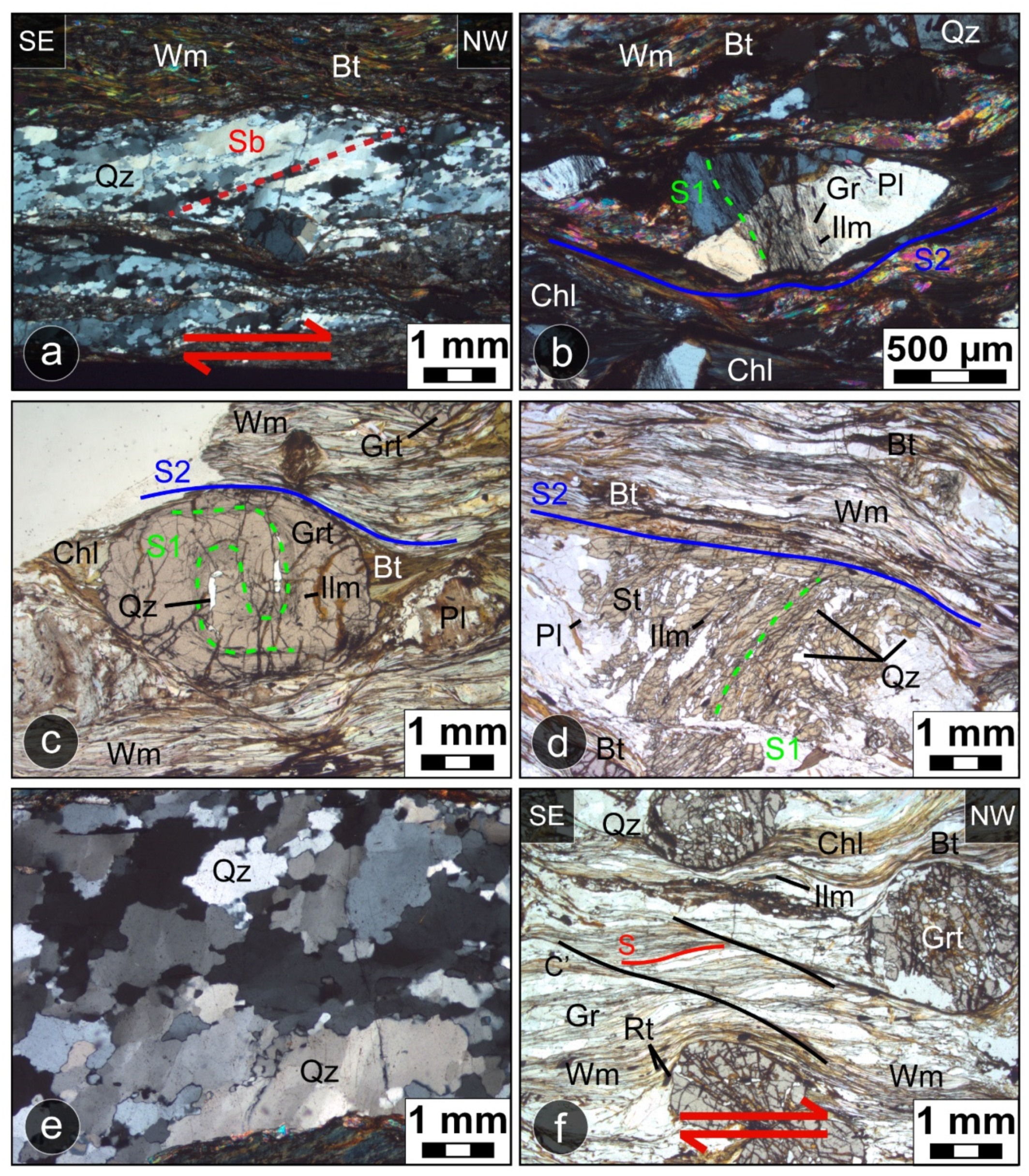
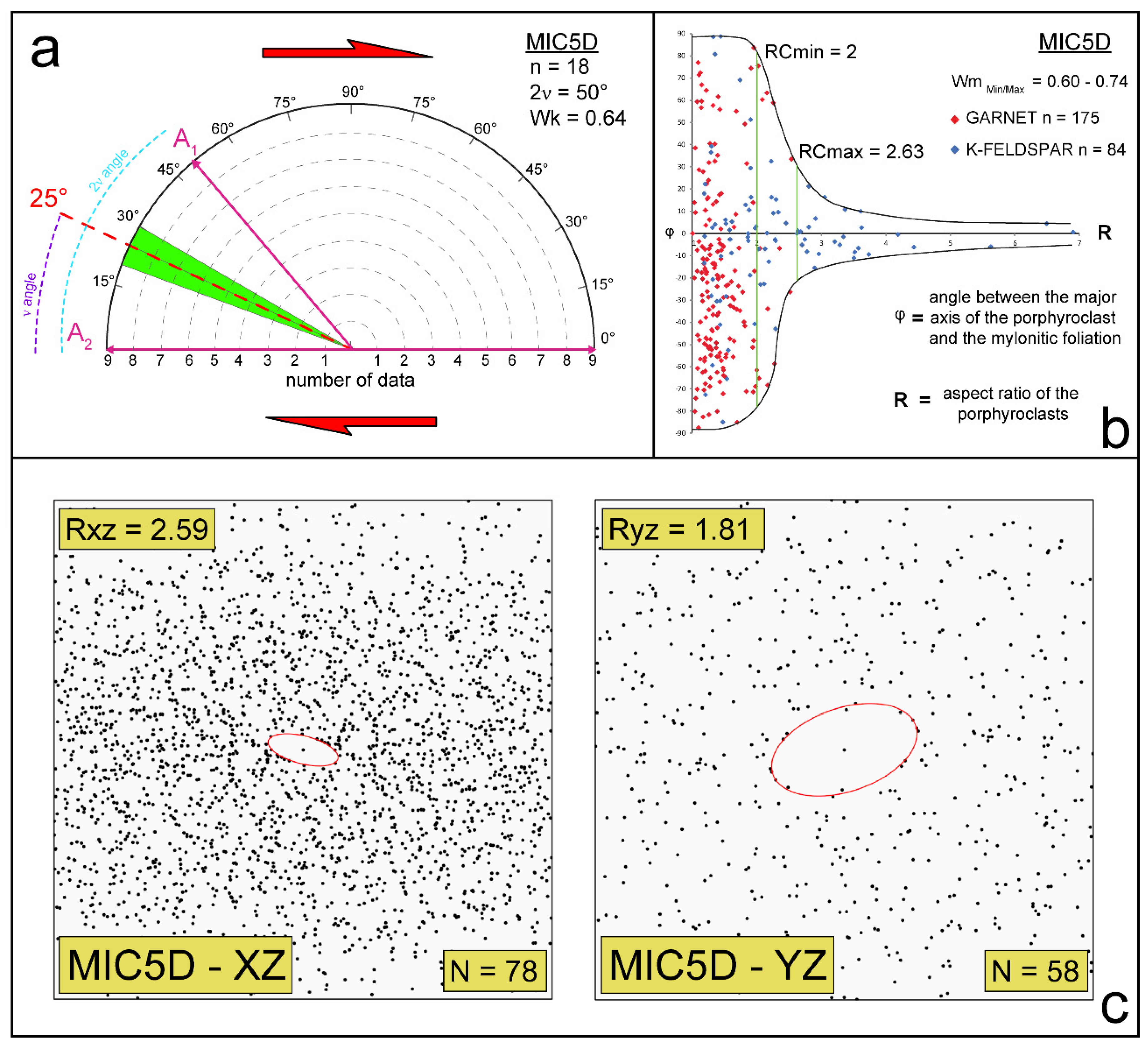
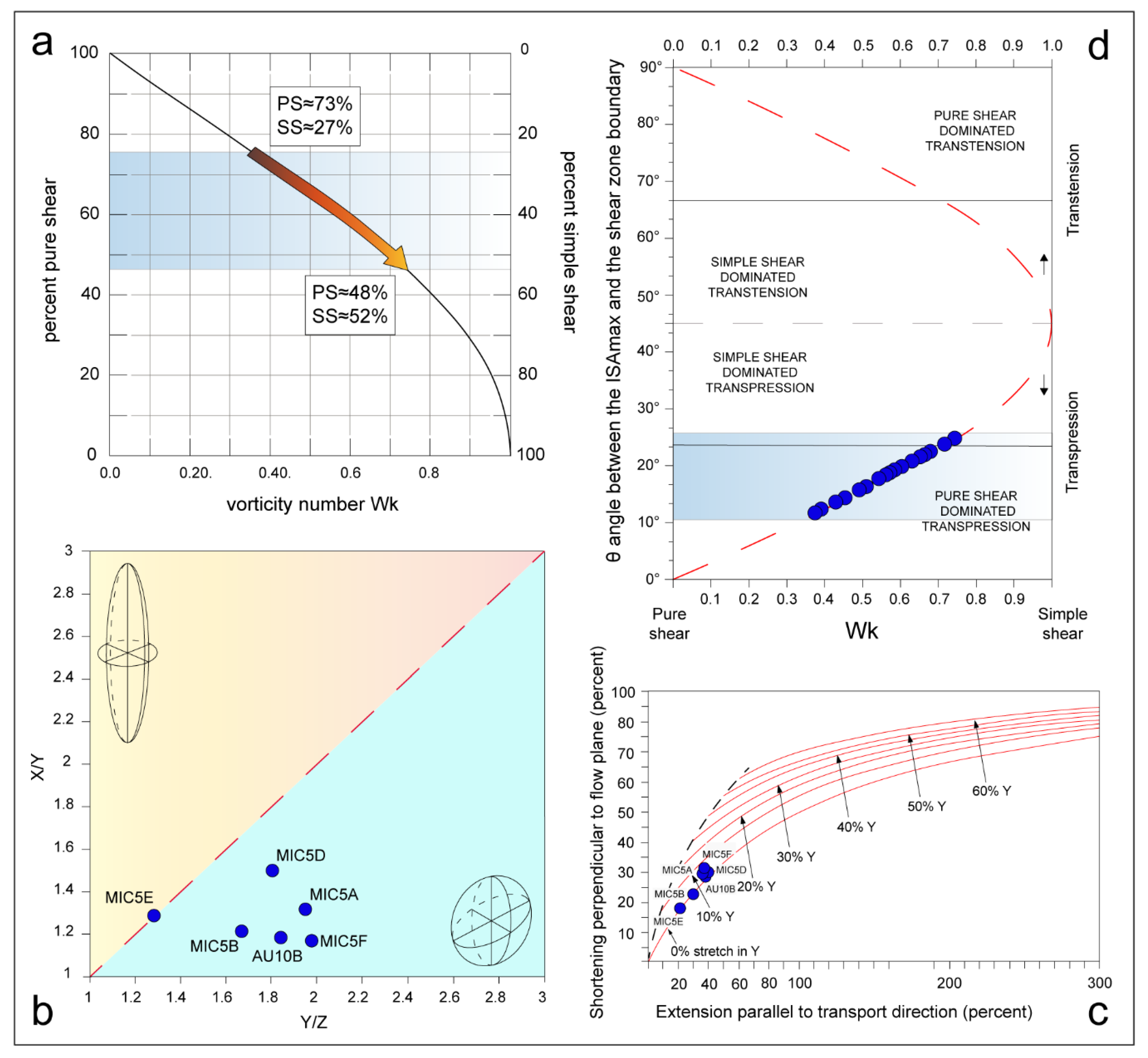
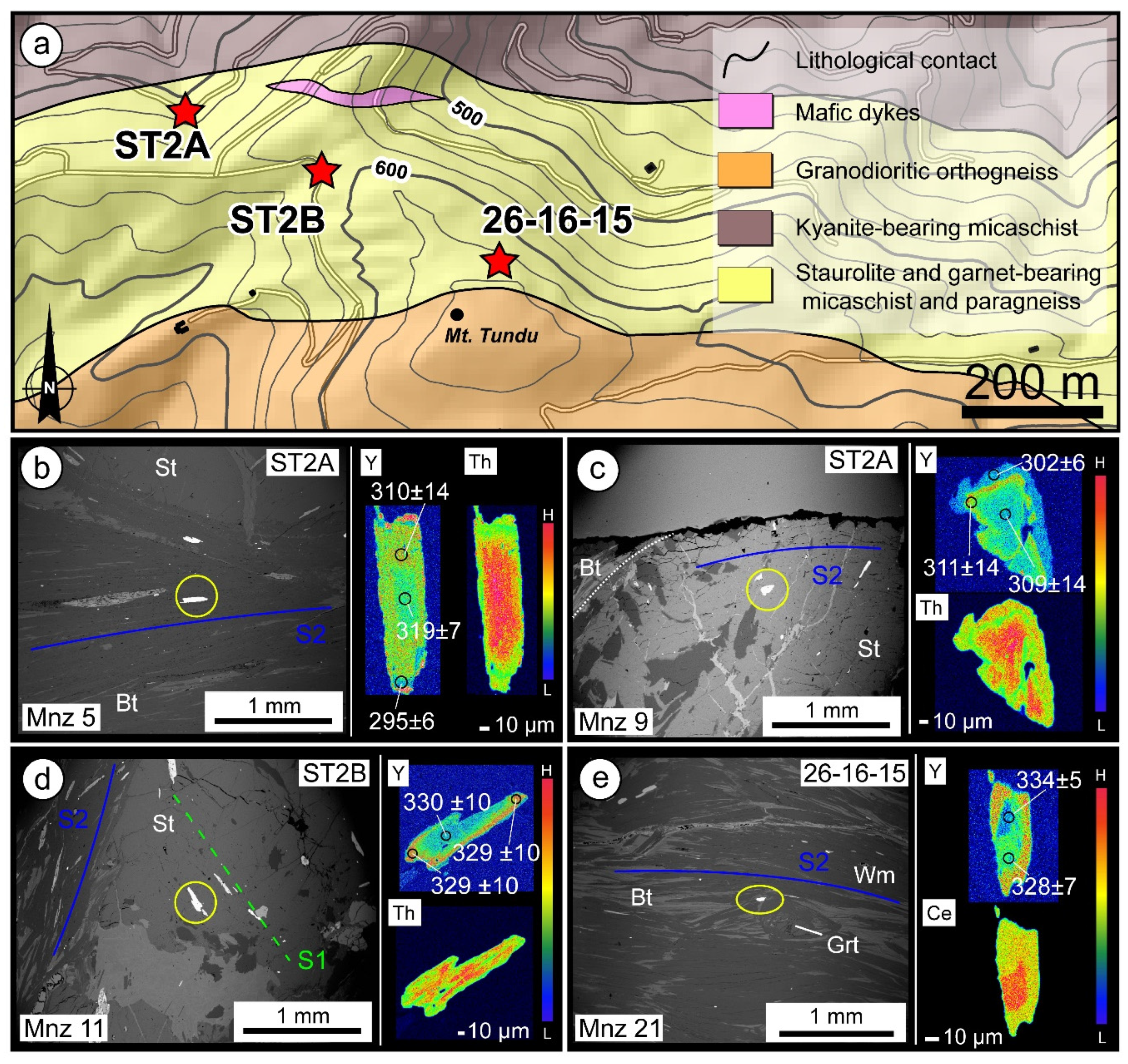
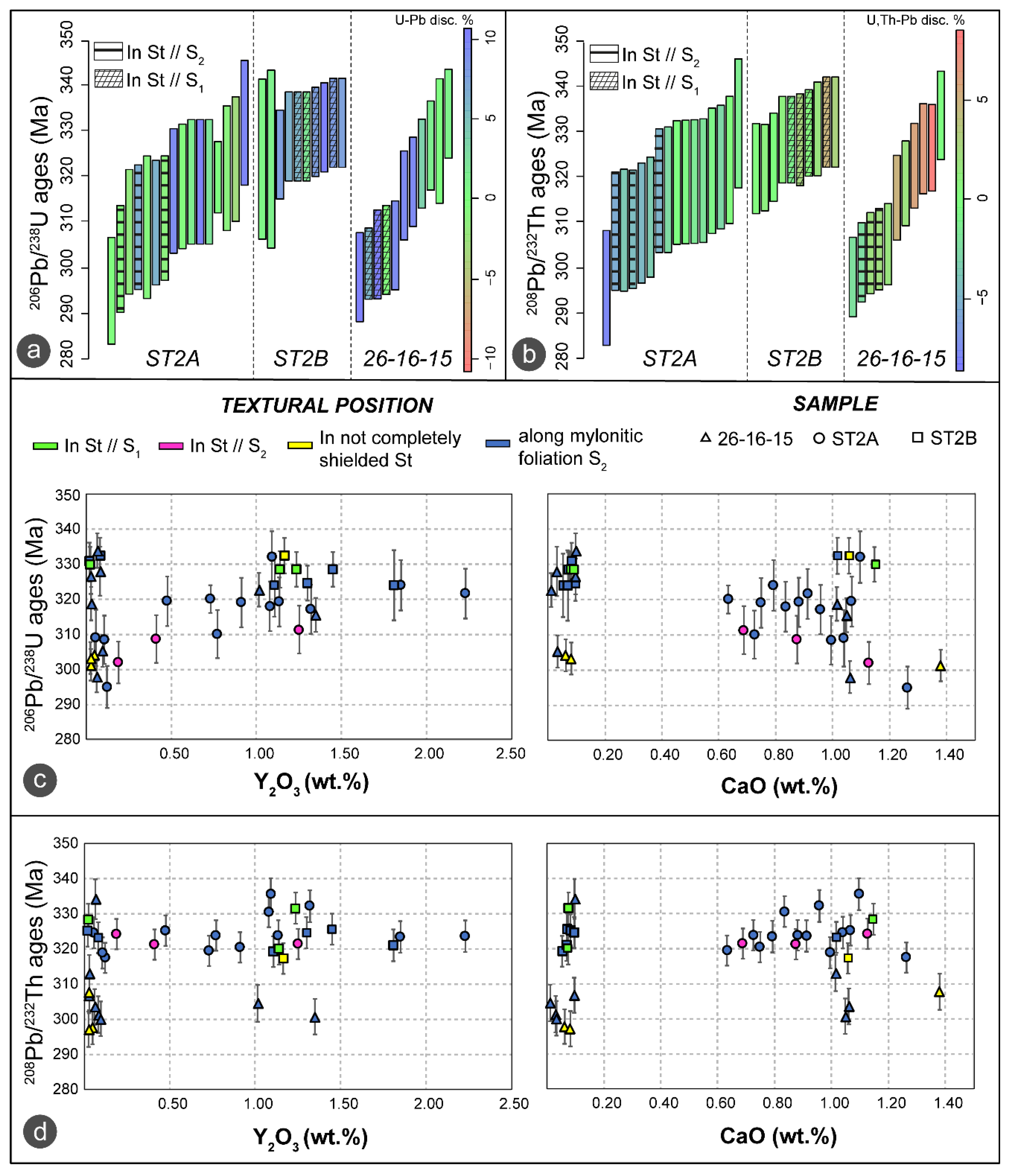
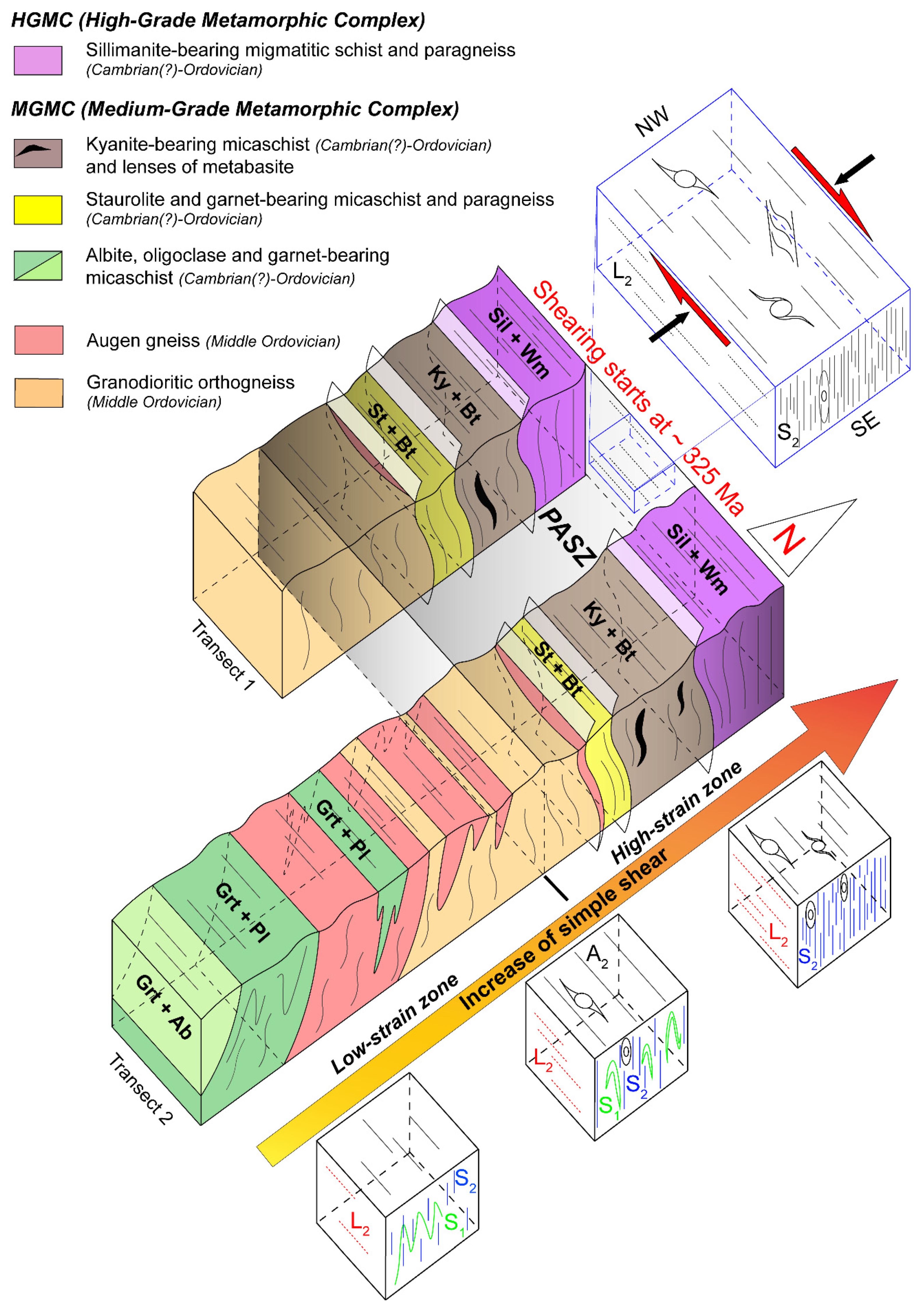

| C’ Shear Bands Method | Porphyroclasts Method | Finite Strain Analysis | Convergence Angle | ||||||||||||||||
|---|---|---|---|---|---|---|---|---|---|---|---|---|---|---|---|---|---|---|---|
| SAMPLE NAME | N | ν ANGLE (°) | 2ν Angle (°) | Wk | θ Angle (°) | N | Rc min | Rc max | Rc m | Wk min | Wk max | Wm | Rxz | Ryz | K | Stretching % | Shortening % | Shear Strain | Convergence Angle |
| SB1 | 39 | 33 | 66 | 0.40 | 12 | - | - | - | - | - | - | - | - | - | - | - | - | - | - |
| SB3 | 21 | 33 | 66 | 0.40 | 12 | - | - | - | - | - | - | - | - | - | - | - | - | - | - |
| FIL1 | 17 | 26 | 52 | 0.61 | 19 | - | - | - | - | - | - | - | - | - | - | - | - | - | - |
| FIL2A | 24 | 32 | 64 | 0.44 | 13 | - | - | - | - | - | - | - | - | - | - | - | - | - | - |
| SA4 | 18 | 27 | 54 | 0.59 | 18 | - | - | - | - | - | - | - | - | - | - | - | - | - | - |
| MIC5A | 16 | 27 | 54 | 0.59 | 18 | 154 | 1.73 | 2.00 | 1.86 | 0.50 | 0.60 | 0.55 | 2.40 | 1.91 | 0.29 | 37 | 29 | 0.55 | 54° |
| MIC5B | - | - | - | - | - | 219 | 1.64 | 2.37 | 2.00 | 0.45 | 0.69 | 0.57 | 1.96 | 1.69 | 0.24 | 31 | 24 | 0.38 | 57° |
| MIC5C | - | - | - | - | - | 231 | 1.75 | 2.10 | 1.92 | 0.51 | 0.63 | 0.57 | - | - | - | - | - | - | - |
| MIC5D | 18 | 25 | 50 | 0.64 | 20 | 259 | 2.00 | 2.63 | 2.31 | 0.60 | 0.74 | 0.67 | 2.59 | 1.81 | 0.53 | 41 | 30 | 0.58 | 51° |
| MIC5E | 22 | 28 | 56 | 0.57 | 17 | - | - | - | - | - | - | - | 1.67 | 1.30 | 0.97 | 21 | 18 | 0.27 | 59° |
| MIC5F | - | - | - | - | - | 67 | 1.63 | 2.12 | 1.87 | 0.45 | 0.63 | 0.54 | 2.25 | 1.96 | 0.16 | 39 | 29 | 0.42 | 57° |
| MIC4 | - | - | - | - | - | 49 | 1.37 | 2.00 | 1.68 | 0.41 | 0.60 | 0.50 | - | - | - | - | - | - | - |
| SC.4 | 44 | 29 | 58 | 0.53 | 16 | - | - | - | - | - | - | - | - | - | - | - | - | - | - |
| SC.5 | 26 | 26 | 52 | 0.61 | 19 | - | - | - | - | - | - | - | - | - | - | - | - | - | - |
| C19’ | 61 | 32 | 64 | 0.44 | 13 | - | - | - | - | - | - | - | - | - | - | - | - | - | - |
| C19’’’ | 67 | 31 | 62 | 0.47 | 14 | - | - | - | - | - | - | - | - | - | - | - | - | - | - |
| SC.50 | 61 | 26 | 52 | 0.61 | 19 | - | - | - | - | - | - | - | - | - | - | - | - | - | - |
| ST13 | 17 | 26 | 52 | 0.61 | 19 | - | - | - | - | - | - | - | - | - | - | - | - | - | - |
| SC.40 | 59 | 29 | 58 | 0.53 | 16 | - | - | - | - | - | - | - | - | - | - | - | - | - | - |
| ST2B | 32 | 25 | 50 | 0.64 | 20 | - | - | - | - | - | - | - | - | - | - | - | - | - | - |
| AU10A | 29 | 29 | 58 | 0.53 | 16 | 183 | 1.71 | 2.20 | 1.95 | 0.50 | 0.66 | 0.58 | - | - | - | - | - | - | - |
| AU10B | 41 | 31 | 62 | 0.47 | 14 | 126 | 1.30 | 1.75 | 1.52 | 0.27 | 0.51 | 0.39 | 2.05 | 1.84 | 0.14 | 38 | 28 | 0.34 | 60° |
| AU12 | 17 | 29 | 58 | 0.53 | 16 | - | - | - | - | - | - | - | - | - | - | - | - | - | - |
| SC.21 | 77 | 23 | 46 | 0.69 | 21 | - | - | - | - | - | - | - | - | - | - | - | - | - | - |
| ST3 | 26 | 25 | 50 | 0.64 | 20 | - | - | - | - | - | - | - | - | - | - | - | - | - | - |
| M.6 | 56 | 23 | 46 | 0.69 | 21 | - | - | - | - | - | - | - | - | - | - | - | - | - | - |
| SC.11 | 40 | 22 | 44 | 0.72 | 22 | - | - | - | - | - | - | - | - | - | - | - | - | - | - |
| 14-5-C1 | 36 | 24 | 48 | 0.67 | 20 | - | - | - | - | - | - | - | - | - | - | - | - | - | - |
| MIG1 | 23 | 22 | 44 | 0.72 | 22 | - | - | - | - | - | - | - | - | - | - | - | - | - | - |
| MIG2 | 30 | 21 | 42 | 0.74 | 24 | - | - | - | - | - | - | - | - | - | - | - | - | - | - |
© 2020 by the authors. Licensee MDPI, Basel, Switzerland. This article is an open access article distributed under the terms and conditions of the Creative Commons Attribution (CC BY) license (http://creativecommons.org/licenses/by/4.0/).
Share and Cite
Carosi, R.; Petroccia, A.; Iaccarino, S.; Simonetti, M.; Langone, A.; Montomoli, C. Kinematics and Timing Constraints in a Transpressive Tectonic Regime: The Example of the Posada-Asinara Shear Zone (NE Sardinia, Italy). Geosciences 2020, 10, 288. https://doi.org/10.3390/geosciences10080288
Carosi R, Petroccia A, Iaccarino S, Simonetti M, Langone A, Montomoli C. Kinematics and Timing Constraints in a Transpressive Tectonic Regime: The Example of the Posada-Asinara Shear Zone (NE Sardinia, Italy). Geosciences. 2020; 10(8):288. https://doi.org/10.3390/geosciences10080288
Chicago/Turabian StyleCarosi, Rodolfo, Alessandro Petroccia, Salvatore Iaccarino, Matteo Simonetti, Antonio Langone, and Chiara Montomoli. 2020. "Kinematics and Timing Constraints in a Transpressive Tectonic Regime: The Example of the Posada-Asinara Shear Zone (NE Sardinia, Italy)" Geosciences 10, no. 8: 288. https://doi.org/10.3390/geosciences10080288
APA StyleCarosi, R., Petroccia, A., Iaccarino, S., Simonetti, M., Langone, A., & Montomoli, C. (2020). Kinematics and Timing Constraints in a Transpressive Tectonic Regime: The Example of the Posada-Asinara Shear Zone (NE Sardinia, Italy). Geosciences, 10(8), 288. https://doi.org/10.3390/geosciences10080288










